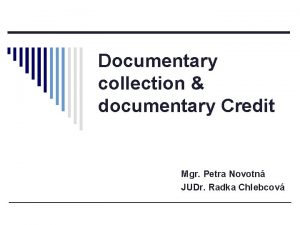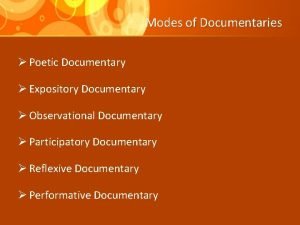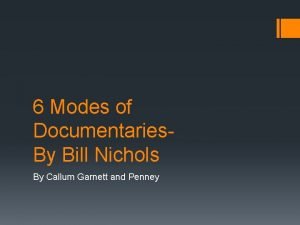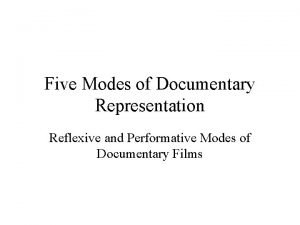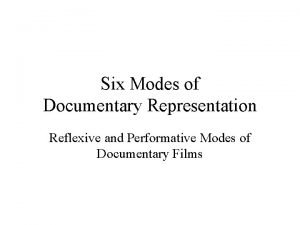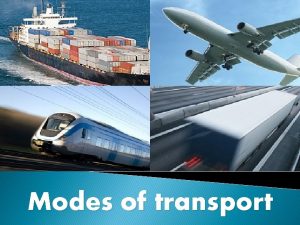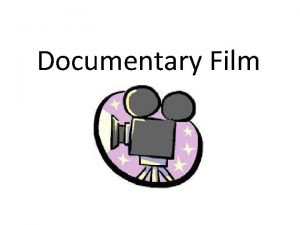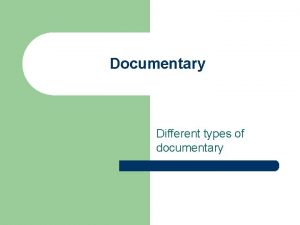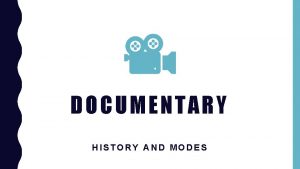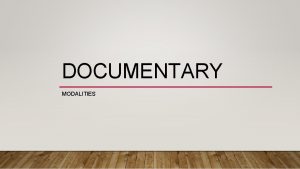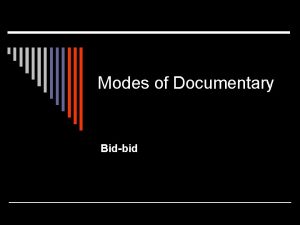The Five modes of documentary OCR level 3







- Slides: 7

The Five modes of documentary OCR level 3 unit 2 documentary research.

Ø Identifying modes of documentary is a way of categorising different types of documentary and is similar to genre categories in feature films. There are overlaps in the different modes and documentaries will often feature conventions from more than one mode.

Expository Voiceover, addresses the audience directly: The voiceover may be a ‘voice of God’ commentator (heard but not seen) or ‘voice of authority’ (seen and heard- usually an expert in the relevant field). Ø Images are used to illustrate (or sometimes counterpoint) the voiceover; Ø Editing is used for continuity, to link together images which support the argument put forward in the voiceover; Ø Assembles a variety of footage, interviews, stills, archive material to support the argument; Ø Attempts to persuade the audience of a particular point of view, often by appealing to logic and the idea of a common sense response. (Soul deep – a history of Black soul music, historical / nature/ science documentaries etc – traditional form of documentary) Ø Ø

Documentary conventions – Observational mode. Location shooting- handheld cameras. Ø Long takes dominate Ø Synchronous (direct) sound recording Ø No voiceover (in its purest form) Ø No interviews Ø Documentary makers presence is hidden Ø Subjects pretend they are not being filmed. (The Swenka, Etre Avoir, Mitchell & Kenyon) Ø

Participatory (also referred to as interactive) Ø Ø Ø Ø Ø Documentary maker (and crew) interact with subject; Interviews dominate but tend to be formal- literally ‘on the run’ questioning; Use of archive material- stills, news; footage, newspaper headlines, letters etc; Location shooting- handheld camera; Long takes dominate; Synchronous (direct) sound recording; Voiceover- usually by the documentary maker; Documentary maker is visible to the audience. Intervenes and participates in the action. (Supersize me, Biggie and Tupac, louis therox, michel moore)

Reflexive documentary Borrows techniques from fiction film for an emotional, subjective response; Ø Emphasises the expressive nature of film, anti realist techniques e. g, re enactments, expressive lighting, dramatic music; Ø Voiceover (When present) is likely to be questioning and uncertain – rather than authoritative; Ø Reliance on suggestion rather than fact; (The Swenka (has elements of reflexive), Cathy come home, Ø

Performative mode Documentary maker (and crew) interacts with subject. Ø Documentary maker comments on the process of making the documentary. Ø The documentary is often shaped in to the narrative of an investigation or search- which there may be no satisfactory conclusion to. Ø Addresses the audience in an emotional and direct way. Ø Subject matter often to do with identity (gender, sexuality)- rather than ‘factual’ subjects. Ø Forgotten Silver Ø

